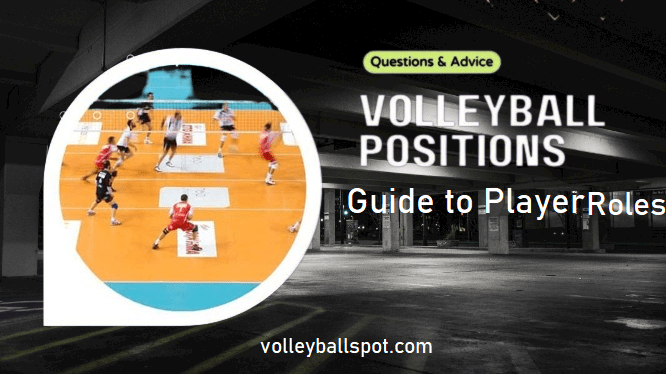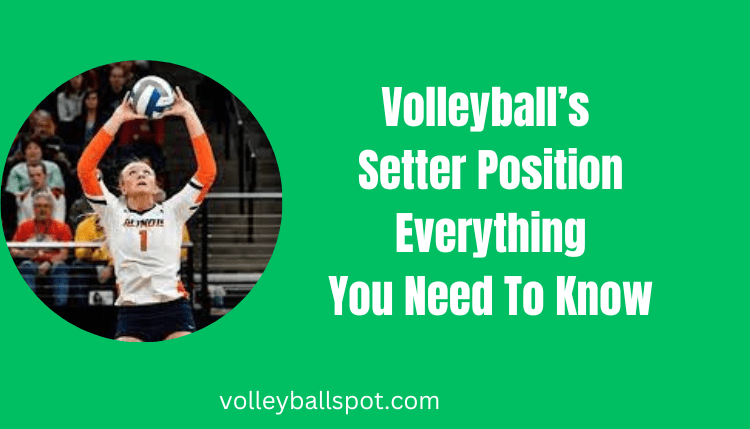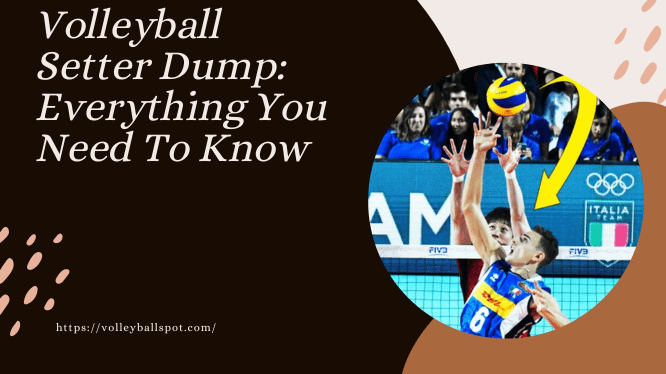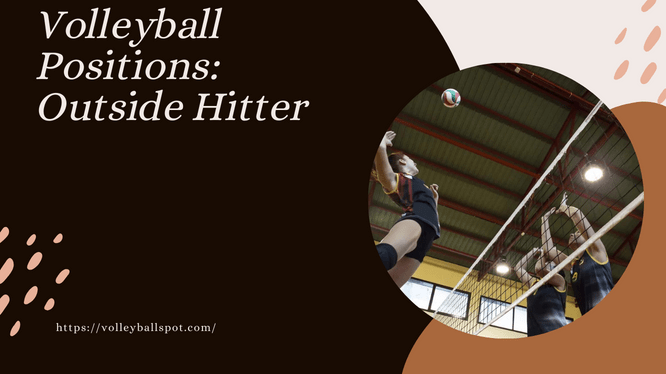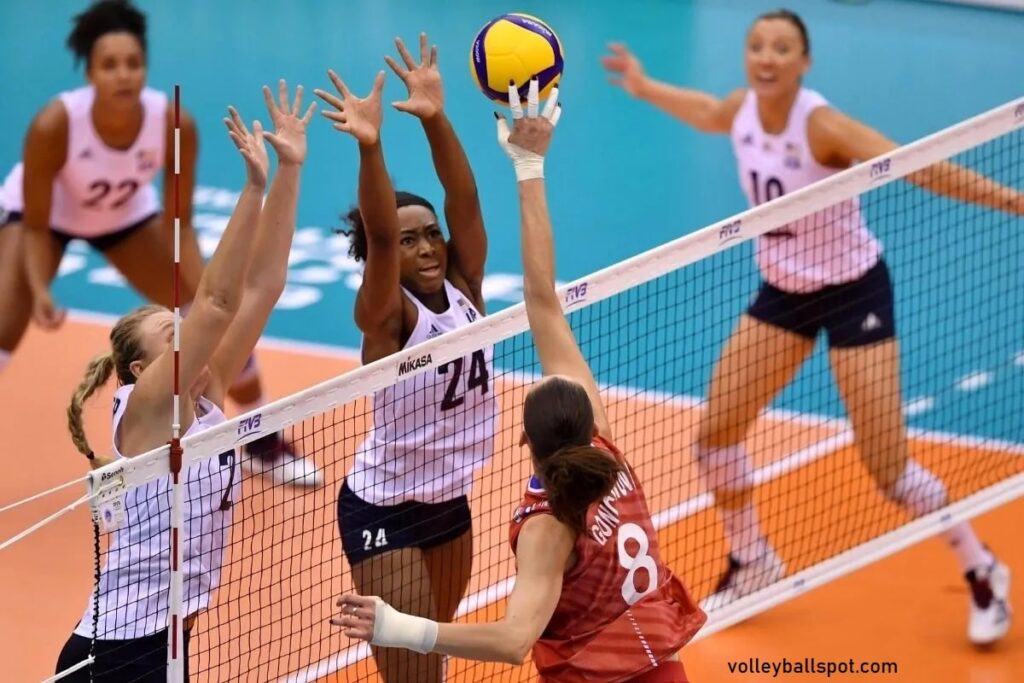
The middle blocker plays a crucial role in volleyball, responsible for both blocking the opponent’s attacks and executing quick sets from the center of the court. To excel in this position, a middle blocker needs to possess a combination of height, athleticism, and technical skills to effectively contribute to their team’s success.
Middle blockers play a vital role in the team’s defense. They are the first line of defense against the opposing team’s attacks. Middle blockers need to be able to read the hitter and move quickly to the block. They also need to be able to jump high and reach above the net.
Middle blockers are also an important part of the team’s offense. They can hit quick sets from the middle of the court. Quick sets are sets that are set quickly and close to the net. Middle blockers need to be able to jump high and hit the ball with power.
To become a good middle blocker, you need to practice regularly. You should work on your blocking, digging, passing, and hitting. You should also watch film of yourself and other middle blockers to identify areas where you can improve.
What is a middle blocker in volleyball?
A middle blocker in volleyball is a player who plays in the middle of the court, between the two outside hitters. They are responsible for blocking the opposing team’s attacks and hitting quick sets from the middle of the court. Middle blockers need to be tall and athletic, and they also need to have good hand-eye coordination and timing.
The Middle Blocker as an Attacker
Middle blockers, also known as middle hitters, are a vital part of any volleyball team. They play a key role in both offense and defense, but their primary responsibility is attacking the middle third of the court. In some offensive systems, middle blockers may also attack behind the setter.
Middle attacks are typically fast-paced and designed to put pressure on the opposing blockers. Here are three common types of middle attacks:
- 1-set: This is a quick set that is set close to the net. Middle blockers must be able to jump high and hit the ball with power to be successful with the 1-set.
- 31-set: This is a set that is set further away from the net than the 1-set. It is a more challenging attack, but it can be effective if the middle blocker can time their jump perfectly.
- Slide set: This is a set that is set to the middle blocker as they are sliding across the court. The slide set is a difficult attack to defend because it is unpredictable and allows the middle blocker to hit the ball from a variety of angles.
Middle blockers can also use their height and athleticism to create scoring opportunities for their teammates. For example, they can set screens for the outside hitters or tip the ball over the blockers.
The 1-Set and the 31-Set: Two Powerful Volleyball Attacks
The 1-set and the 31-set are two of the most powerful volleyball attacks. They are both designed to force the middle blocker to make a difficult decision: block the quick attack or defend the outside attack?
The 1-Set
The 1-set is a quick set that is set close to the net, in front of and very close to the setter. The middle blocker has to decide whether to block the 1-set or stay with the outside hitter. If the middle blocker blocks the 1-set, they risk being late to block the outside attack if that is where the set is directed.
The 31-Set
The 31-set in volleyball is similar to the 1-set, but it is set a distance away from the setter. This puts pressure on the middle blocker to make a quick decision. They must choose whether to stay with the 31 attacker and risk defending against an attack from the right-side attacker, or focus on blocking the right-side attack and challenge themselves to block the 31’s attack as well.
How to Defend the 1-Set and the 31-Set
The best way to defend the 1-set and the 31-set is to be prepared for both attacks. Middle blockers need to be able to read the setter and move quickly to the block. They also need to be able to communicate with their teammates to coordinate their defense.
Outside hitters can also help to defend the 1-set and the 31-set by covering the open space on the court. If the middle blocker blocks the 1-set, the outside hitter should be ready to defend the outside attack. If the middle blocker stays with the 31 attacker, the outside hitter should be ready to defend the attack from the right side.
Conclusion
The 1-set and the 31-set are two powerful volleyball attacks that can be difficult to defend. However, by being prepared for both attacks and communicating with their teammates, middle blockers and outside hitters can minimize the damage.
Slide Attack: A Powerful Volleyball Attack
The slide attack is a powerful volleyball attack that can be used to score points against any opponent. When executed correctly, the slide attack can force the blockers to defend the entire net and put a lot of offensive pressure on the opponent’s left front blocker.
The Middle Hitter’s Challenge: Attacking from Serve-Receive and Transition
Attacking the 1-set, the 31-set, and the slide from a serve-receive scenario is a challenging task for middle hitters. They need to quickly establish the correct court position relative to the setter and coordinate their attack approach with the timing of a fast-tempo set. Transition attacking in volleyball poses additional challenges for the middle hitter as they must swiftly transition from blocking to getting into a “home base” position for the next play. This requires quick footwork and awareness to be ready for the next offensive opportunity.

Middle Blocker Home Base Position
The middle blocker home base position is a spot on the court where the middle blocker can go to regroup and get into position to attack after blocking. A good home base is usually a few steps behind the setter and depends on the location of the block.
After blocking, the middle blocker should drop directly off the net and then use visual cues and the team’s offensive system to approach the net to attack the 1-set, the 31-set, or a slide attack.
Responsibilities for the Middle Blocker
The middle blocker position is crucial to any team’s defensive success. Their primary duty is to block the middle one-third of the court, but they must also be prepared to defend the outside attack if needed.
Since the court is nine meters wide, the ability to quickly move laterally is essential for middle blockers. They must also be able to read the offense and anticipate where the attack is coming from.
To facilitate lateral movement, middle blockers should start in a balanced position with their hands at chest level or lower.
There are many different footwork patterns that middle blockers can use, depending on the situation. Here are four of the most common:
Shuffle Step Block Footwork: A Guide for Volleyball Players
The shuffle step block is a fundamental footwork pattern for volleyball players, especially middle blockers. It is used when the blocker needs to move a short distance to the point of attack or when they have sufficient time to get there.
The shuffle step is a relatively easy movement to learn, but it is important to master it in order to be an effective blocker. Here is a step-by-step guide:
- Start in a balanced position with your feet shoulder-width apart and your hands in front of your chest.
- Take a small step with your lead foot in the direction you want to move.
- Slide your back foot to catch up with your lead foot.
- Repeat steps 2 and 3 until you reach the point of attack.
- Jump from your lead foot and block the ball.
Advantages of the shuffle step block:
- The shuffle step allows the blocker to stay square to the net, which is important for blocking effectively.
- The shuffle step is a relatively easy movement to learn, making it a good option for younger players.
Disadvantages of the shuffle step block:
- The shuffle step is slower than the crossover step, so it is not the best option for blocking long distances or when the tempo of the opposing offense is fast.
Tips for using the shuffle step block:
- Practice the shuffle step block regularly so that it becomes second nature.
- Be aware of your surroundings and anticipate where the attack is coming from.
- Start your shuffle step block early so that you have enough time to reach the point of attack.
- Stay square to the net and use your hands to block the ball.
With practice, you can master the shuffle step block and become a more effective blocker.
3-Step Crossover Block Footwork: A Guide for Middle Blockers
The 3-step crossover block is a fundamental footwork technique utilized by middle blockers to effectively block outside hitters. This pattern offers versatility in different game scenarios and enables the blocker to generate significant momentum for a powerful jump.
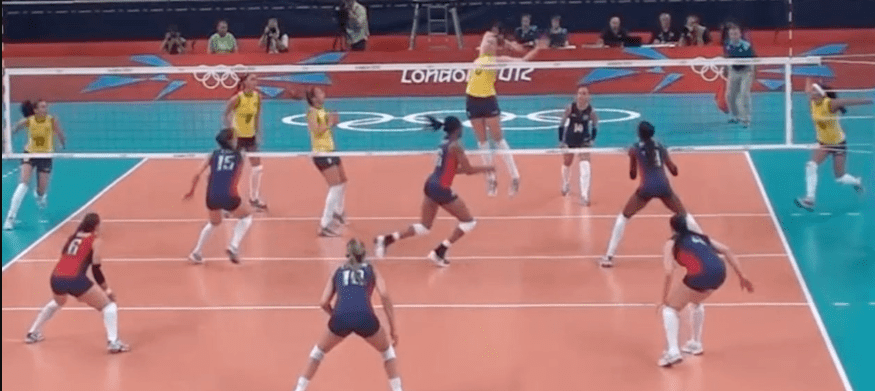



Here is a step-by-step guide to the three-step crossover block:
- Start in a balanced position with your feet shoulder-width apart and your hands in front of your chest.
- Take a big step with your lead foot in the direction you want to move.
- Crossover with your back foot and land with your feet shoulder-width apart again.
- Take a small hop step with your lead foot to generate momentum.
- Jump from your lead foot and block the ball.
Tips for using the three-step crossover block:
- Practice the three-step crossover block regularly so that it becomes second nature.
- Be aware of your surroundings and anticipate where the attack is coming from.
- Start your three-step crossover block early so that you have enough time to reach the point of attack.
- Stay square to the net and use your hands to block the ball.
Two-Step Hop Block Footwork
The two-step hop block is another common footwork pattern for middle blockers when they need to block outside. It is a simpler pattern to learn than the three-step crossover block, but it does not generate as much momentum.
Here is a step-by-step guide to the two-step hop block:
- Start in a balanced position with your feet shoulder-width apart and your hands in front of your chest.
- Take a big step with your lead foot in the direction you want to move.
- Hop with your back foot and land next to your lead foot.
- Jump from your lead foot and block the ball.
Tips for using the two-step hop block:
- Practice the two-step hop block regularly so that it becomes second nature.
- Be aware of your surroundings and anticipate where the attack is coming from.
- Start your two-step hop block early so that you have enough time to reach the point of attack.
- Stay square to the net and use your hands to block the ball.
Which footwork pattern is better?
The best footwork pattern for a middle blocker depends on their individual strengths and weaknesses, as well as the specific situation. Middle blockers should practice both the three-step crossover block and the two-step hop block so that they can choose the right one for each situation.
Here are some general guidelines:
- If the middle blocker has a long distance to cover or needs to generate a lot of power for their jump, they should use the three-step crossover block.
- If the middle blocker needs to block a short distance quickly, they should use the two-step hop block.
- Middle blockers should also take into account the tempo of the opposing offense. If the offense is running a fast tempo, the middle blocker will need to use a faster footwork pattern, such as the two-step hop block.
Ultimately, the best way to determine which footwork pattern is best for you is to experiment and see what feels most comfortable and effective.
Two-Step Crossover Block vs. Two-Step Hop Block
The two-step crossover block and the two-step hop block are both common footwork patterns for middle blockers when they need to block outside. The difference is that in the crossover block, the blocker runs into the block jump, while in the hop block, the blocker jumps into the block.
Here is a more detailed comparison of the two footwork patterns:
Two-Step Crossover Block
- Advantages:
- More versatile and can be used in a variety of situations
- Generates more momentum for a higher jump
- Disadvantages:
- More difficult to learn and master
- Can be slower than the two-step hop block for shorter distances
Two-Step Hop Block
- Advantages:
- Easier to learn and master
- Faster than the two-step crossover block for shorter distances
- Disadvantages:
- Less versatile and cannot be used in as many situations
- Generates less momentum for a lower jump
Which footwork pattern is better for middle blockers?
The best footwork pattern for a middle blocker depends on their individual strengths and weaknesses, as well as the specific situation. Middle blockers should practice both the two-step crossover block and the two-step hop block so that they can choose the right one for each situation.
Here are some general guidelines:
- If the middle blocker has a long distance to cover or needs to generate a lot of power for their jump, they should use the two-step crossover block.
- If the middle blocker needs to block a short distance quickly, they should use the two-step hop block.
- Middle blockers should also take into account the tempo of the opposing offense. If the offense is running a fast tempo, the middle blocker will need to use a faster footwork pattern, such as the two-step hop block.
Ultimately, the best way to determine which footwork pattern is best for you is to experiment and see what feels most comfortable and effective.
One-Step Crossover Block Footwork: A Quick Guide
The one-step crossover block is a footwork pattern that allows middle blockers to cover the longest possible distance in the shortest amount of time. It is a great option for blocking outside attacks, as it allows the blocker to get to the point of attack quickly and efficiently.
Here is a step-by-step guide to the one-step crossover block:
- Start in a balanced position with your feet shoulder-width apart and your hands in front of your chest.
- Take a big step with your lead foot in the direction you want to move.
- As you step, crossover your back foot behind your lead foot.
- Land with your feet shoulder-width apart again and jump from your lead foot.
Tips for using the one-step crossover block:
- Practice the one-step crossover block regularly so that it becomes second nature.
- Be aware of your surroundings and anticipate where the attack is coming from.
- Start your one-step crossover block early so that you have enough time to reach the point of attack.
- Stay square to the net and use your hands to block the ball.
Why use the one-step crossover block?
The one-step crossover block is a great option for middle blockers because it allows them to cover a lot of distance in a short amount of time. This is especially important when blocking outside attacks, as the hitter has more time to set and hit the ball.
The one-step crossover block is also a good option for middle blockers who are not as quick or agile as others. By taking a big step with their lead foot and crossing their back foot behind it, they can generate more momentum and reach the point of attack more quickly.
When to use the one-step crossover block:
The one-step crossover block should be used when the middle blocker needs to cover a long distance to block outside. It is also a good option for middle blockers who are not as quick or agile as others.
Here are some specific situations where the one-step crossover block can be used:
- When the hitter is setting up outside
- When the hitter is a high jumper
- When the hitter is hitting a quick set
- When the middle blocker is not as quick or agile as others
Conclusion
The role of the middle blocker in volleyball is undeniably a pivotal one, often described as the “quarterback of the net.” This multifaceted position demands a unique blend of agility, anticipation, and tactical prowess. From the split-second decisions at the net to the synchronized dance with the setter, the middle blocker is the linchpin of the team’s defense and a potent weapon on the attack.
As we’ve explored, mastering the middle blocker position is no small feat. It requires unwavering dedication, continuous improvement, and a relentless pursuit of perfection. But in return, it offers the chance to be the unsung hero, the game-changer, the one who makes that critical block, that thunderous spike, or that perfectly timed tip.
To all those aspiring to embrace the role of the Middle Blocker Volleyball Position, welcome the challenge, refine your footwork, and cultivate your blocking and attacking skills. Elevate your game and let your presence at the net inspire your team to reach new heights. The Middle Blocker Volleyball Position is not just a role; it’s a force to be reckoned with. With dedication and passion, you can truly become the embodiment of excellence in this vital position, leaving an indelible mark on the game.
FAQs
How should a middle blocker move?
A middle blocker’s movement is crucial in volleyball. They need to be quick and agile, ready to move laterally and vertically. The key is to react to the setter’s decisions and anticipate the opponent’s attack. Effective footwork, including lateral shuffling and quick jumps, is essential to block or hit at the net.
Why don’t middle blockers serve?
Middle blockers are often not primary servers because they play a pivotal role at the net. Serving requires players to be in the back row, and middle blockers are typically positioned at the net to block and attack. However, some middle blockers do serve in certain game situations or rotations.
What can a middle blocker do in volleyball?
A middle blocker in volleyball plays a versatile role. They are responsible for blocking the opponent’s attacks at the net, which is their primary duty. Additionally, middle blockers can contribute to the team’s offense by executing quick attacks and creating opportunities for points. They are key players in both defense and offense.
Do middle blockers play back row?
Middle blockers typically do not play in the back row during rotations. They are specialized in front-row play, focusing on blocking and attacking at the net. When they rotate to the back row, a libero or defensive specialist usually substitutes in for them. This rotation strategy ensures that the team maintains optimal offensive and defensive positions.
Where does the middle blocker play?
The middle blocker primarily plays at the net, taking positions along the middle of the court. They are strategically placed in front of the setter and are ready to block the opponent’s attacks. Middle blockers move laterally along the net and jump to block spikes, making them a critical component of the team’s net defense.
Can a middle blocker receive?
While middle blockers are not typically known for their receiving skills, they can and should contribute to back-row defense when necessary. In certain game situations, middle blockers may be called upon to receive serves or dig balls to keep the rally going. Their primary focus remains at the net, but versatility in all aspects of the game is highly valued.

